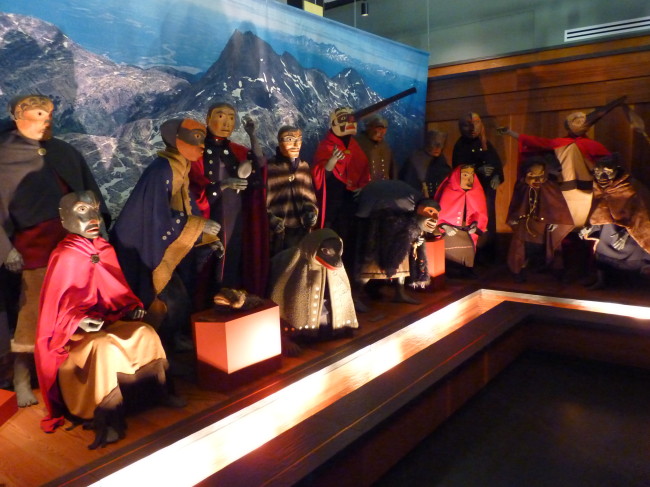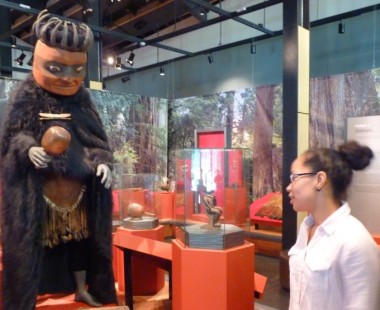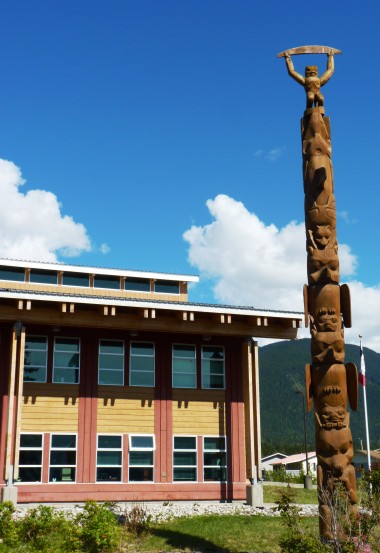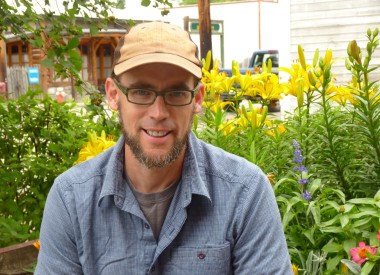Some Alaska tribal organizations say the August 4th dam break at a British Columbia mine shows what could happen at proposed near-border mines. But some B.C. tribal governments strongly support development.

“Here you’ll see some of the types of ways that we use oolichans. They’re sun-dried as well as smoked.”
Kerry Small explains what’s in a display case in northwest British Columbia’s Nisga’a Museum. It’s a gleaming, glass-fronted building in a wide valley about 20 miles from the Alaska border.
The valley surrounds the Nass River, home to the Nisga’a Nation and its tribal government, which is at the forefront of Canada’s aboriginal rights movement.
Small points to a carved, rectangular, wooden dish used to process oolichans, also called hooligan or candlefish.
“The bottom’s laid with fern and you cook it down, and that’s how you create the grease. And this is oolichan grease. It’s like liquid gold. It’s one of the most valuable items still to this day,” she says.

Kevin McKay, executive chairman of the Nisga’a Government’s legislature, says the Nisga’a people depend on the health of the Nass River to keep the oolichan coming, as well as salmon.
“The oolichan has been called the survival fish because it’s a very important part of our cycle of food that we get in abundance,” McKay says.
But they also need jobs.
That’s one of the reasons the tribal government signed an agreement this summer pledging support for the Kerr-Sulpherrets-Mitchell Mine, under development to the north.
“What we told our citizens … (is) we have taken every measure and every opportunity to mitigate those environmental impacts throughout the life of the project,” he says.
KSM will store its tailings–ground up rock leftover from ore processing–behind dams within the Naas River watershed.
“We had some concerns with the original design they had presented throughout the course of our negotiations,” he says.

McKay says those changes will cost the developer a couple hundred million dollars. KSM says changes made to address aboriginal concerns bring the amount to $500 million.
“Now I dare say, without that significant move by the proponent, it may not have been possible for the parties to reach a mutual agreement.”
Total development costs are estimated at $5.3 billion.
McKay says the Nisga’a-KSM agreement also provides lump-sum payments, training, jobs and environmental protections.
“There are no 100 percent guarantees. We go into this with our eyes wide open,” he says.
The mine faces objections on this side of the border.
“I just firmly, firmly, firmly believe that this is a bad idea,” says Ketchikan’s Rob Sanderson Jr., who co-chairs the Southeast Alaska-based United Tribal Transboundary Mining Work Group. It’s backed by the Tlingit-Haida Central Council, as well as several Southeast communities’ tribal governments.
All the groups say the KSM and other near-border mines could threaten the Unuk, the Stikine or the Taku rivers, which flow from Canada into Alaska.
“We live in a very seismic area of the world and one of the big concerns about the KSM is the scale,” he says.
And it’s not just when the mines are running. Sanderson and other critics worry about the decades–or centuries–after they close, when tailings dams fail.
“If they get up to capacity and production and we have a catastrophic event, that pretty much puts southern Southeast into a dead zone,” he says.
Those objections won the backing of the Washington, D.C.-based National Congress of American Indians this summer. It’s the nation’s largest Native organization. It’s urging Congress, the White House and the State Department to push Canadian officials to increase environmental scrutiny.
But the KSM’s environmental-protection plans are close to approval. And, the Red Chris Mine, owned by the same company that had the dam collapse, is already extracting ore within the Stikine River watershed.
KSM developers have also won support from the Gitxsan Nation, a British Columbia aboriginal government east of Nisga’a territory.

Another tribal government, the Gitanyow Hereditary Chiefs, had opposed the project, but signed an agreement this summer.
“What we’re concerned about is the tailings facility that does drain into Gitanyow territory,” says Fish and Wildlife Biologist Kevin Koch, who works for the Gitanyow Fisheries Authority, a branch of that government.
He says mining’s impacts may not be immediately obvious.
“When some metal or element of some kind is released into water, it might not directly kill fish, but it might impair some part of their physiology or behavior. They might lose their ability to avoid predators, that sort of thing,” he says.
It might also hurt salmon’s sense of smell, which makes it hard to find their spawning grounds.
The Gitanyow’s KSM agreement is not a full endorsement. Rather, it sets some rules and guarantees the tribal government is part of environmental monitoring.
“For Gitanyow to feel that their territory’s protected, they need to be directly involved. They need to have people on the ground taking part in the work, analyzing the work, reporting directly to the chiefs rather than government or industry just reporting annually,” Koch says, speaking as a biologist, not as a tribal representative.
Gitanyow staff have done field work, studying salmon and moose habitat.
Another tribal government, the Tahltan Central Council, has also expressed concerns about transboundary mines.
Mine proponents say that’s part of the assessment process required by government regulators.
Brent Murphy is spokesman and top environmental official for Seabridge Gold, the Kerr-Sulpherrets-Mitchell Mine’s developer.
“The guiding principal behind the design of the KSM project was the protection of the downstream environments,” he says.
Other mine projects concerning tribal groups are Galore Creek and Schaft Creek in the Stikine River watershed, and Tulsequah Chief near the Taku River.
Ed Schoenfeld is Regional News Director for CoastAlaska, a consortium of public radio stations in Ketchikan, Juneau, Sitka, Petersburg and Wrangell.
He primarily covers Southeast Alaska regional topics, including the state ferry system, transboundary mining, the Tongass National Forest and Native corporations and issues.
He has also worked as a manager, editor and reporter for the Juneau Empire newspaper and Juneau public radio station KTOO. He’s also reported for commercial station KINY in Juneau and public stations KPFA in Berkley, WYSO in Yellow Springs, Ohio, and WUHY in Philadelphia. He’s lived in Alaska since 1979 and is a contributor to Alaska Public Radio Network newscasts, the Northwest (Public Radio) News Network and National Native News. He is a board member of the Alaska Press Club. Originally from Cleveland, Ohio, he lives in Douglas.




